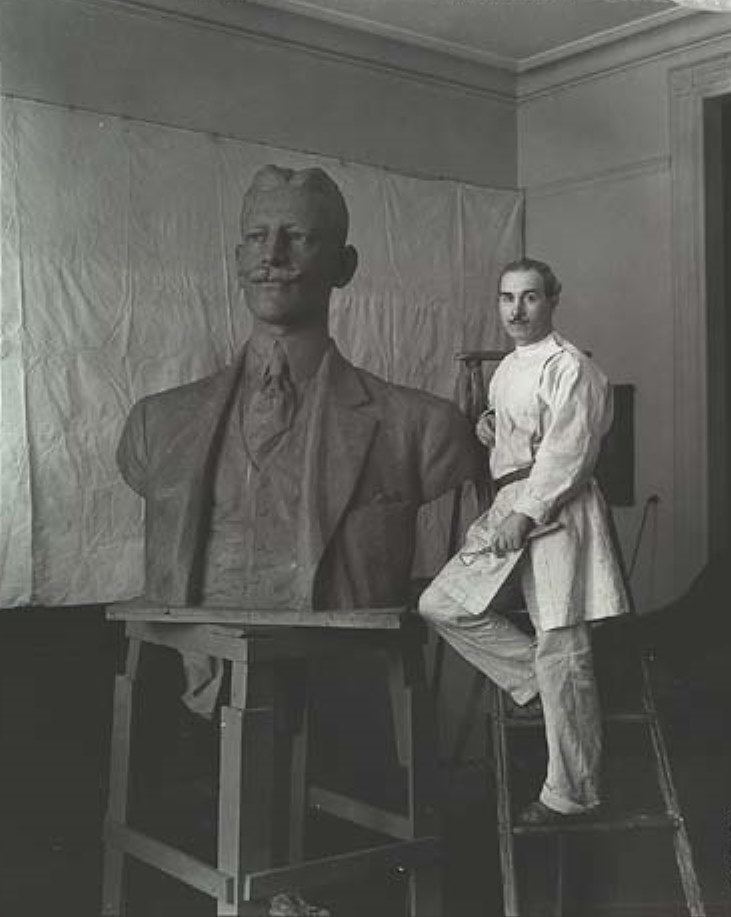Name Pietro Montana | ||
 | ||
Pietro Montana (June 29, 1890 – July 6, 1978) was a 20th-century Italian-American sculptor, painter and teacher, noted for his war memorials and religious works.
Contents
- Biography
- Honors
- Personal
- War memorials
- Religious works
- Other works
- Medallions and miniatures
- Paintings
- References

Biography
He was born in Alcamo, Sicily, the third of six children of Ignazio and Marianna Montana. The family emigrated to the United States in 1904, and settled in Brooklyn, New York City. As a teen, he apprenticed under a photographer, then started his own photography studio in the family home. He attended night classes for six years at the School of Art, Cooper Union, studying under George Thomas Brewster and graduating in 1915. He also studied at the Mechanics Institute.
He made a spectacular professional debut with Fighting Doughboy, the winner in a 1919 war memorial design competition sponsored by the Unity Republican Club of Brooklyn. Rather than a conventional passive figure, he modeled an aggressive soldier with clenched fist, ready to throw a punch. The lifesize sculpture was unveiled in Heisser Park on November 20, 1921. Bronze replicas are in North Arlington, New Jersey; and Alliance, Ohio. Zinc replicas, cast by the J. W. Fiske Architectural Metals Company of New York City, are in Riverdale, New Jersey; Suffern, New York; and elsewhere.
That same year he unveiled a traditional Beaux Arts sculpture for Brooklyn's Freedom Square Park – Victory with Peace – a classical nike (winged goddess), but one who holds aloft an olive branch, instead of a sword.
His next commission, Dawn of Glory, probably is his most famous work. It depicts the soul of a dead soldier wrapped in an American Flag ascending to heaven. The sculpture is a one-and-one-half-lifesize nude, and the bodybuilder Charles Atlas (born Angelo Siciliano) posed for it. It was unveiled in Brooklyn's Highland Park on July 13, 1924.
His Minute Man sculpture for the World War I memorial in East Providence, Rhode Island, is even more intimidating than Fighting Doughboy. The physicality of the soldier is striking – the model may have been Charles Atlas, again – and the knife he clutches (now broken) along with his slashed trousers and wounded thigh suggest that he has just emerged as victor from bloody hand-to-hand combat. The monument was dedicated on July 30, 1927.
His last large-scale war memorial was for the town of Mirabella Imbaccari, Sicily, and was commissioned by Sicilian-Americans living in New York City. It features a bronze, one-and-one-half-lifesize centurion – nude, but for belt, helmet and cape – who protects and comforts a clothed woman collapsed at his feet. Monumento ai Caduti (Monument to the Fallen) was unveiled in 1938, almost twenty years after the end of World War I.
He modeled a bust of Italian engineer Guglielmo Marconi for the 1939 New York World's Fair, and later donated it to the Engineers' Hall of Fame.
Montana co-founded the Leonardo da Vinci School of Art in the late-1920s, where he taught for several years. In the 1930s, he taught at the Roerich Academy of Arts. As artist-in-residence at Fordham University from 1947 to 1952, he taught painting and sculpture, and executed a number of school commissions. Most notable among these are the fourteen Stations of the Cross bas-relief panels in the University Chapel, which feature half-lifesize figures carved out of white oak.
He created commemorative medallions, including two sets of religious medallions for the Franklin Mint. Copies of his 1957 St. Francis of Assisi medallion for the Society of Medalists are in the collections of the Metropolitan Museum of Art, the Museum of Fine Arts, Boston, and other museums.
Honors
He exhibited at the Pennsylvania Academy of the Fine Arts — 1919, 1920, 1924, 1930–1936, 1943–1948); the National Academy of Design — 1918, 1919, 1921, 1931 (Gold Medal for Orphans); the Allied Artists of America — 1932–1949 (Gold Medals 1942 & 1949); and elsewhere.
He was elected an associate of the National Academy of Design in 1968, and an academician in 1970. He was also a member of the National Sculpture Society and the Allied Artists of America.
He received the Daniel Chester French Medal for Religious Sculpture, the Allied Artists of America Award, the Medal of Honor of the Catholic Fine Arts Society and the award of the National Academy of Design.
Personal
He became a naturalized American citizen in 1921. He married Alfrieda Kramer on April 3, 1930, and they lived in Brooklyn, and later Manhattan. The couple moved to Rome, Italy in 1962, where they resided until Alfrieda's death in 1975. Pietro returned to the United States and lived with a niece in Bayville, New York.
Late in life, he donated many of his smaller works to Fordham University and to Capital University, in Columbus, Ohio. He donated his papers to the Archives of American Art at the Smithsonian Institution. A year before his death, he completed an autobiography.
The Pietro and Alfrieda Montana Memorial Prize is awarded annually by the National Sculpture Society.
